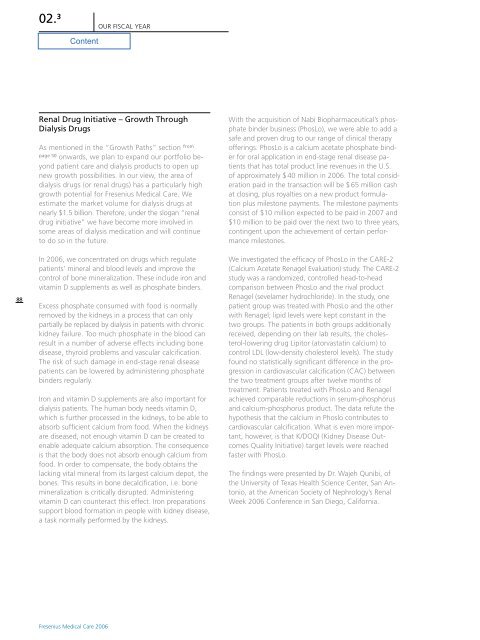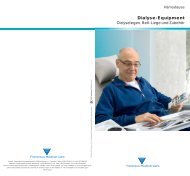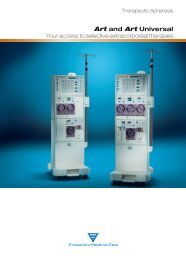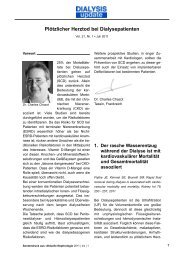Operations and Business Environment - Fresenius Medical Care
Operations and Business Environment - Fresenius Medical Care
Operations and Business Environment - Fresenius Medical Care
Create successful ePaper yourself
Turn your PDF publications into a flip-book with our unique Google optimized e-Paper software.
02. 3<br />
Our Fiscal year<br />
88<br />
Renal Drug Initiative – Growth Through<br />
Dialysis Drugs<br />
As mentioned in the “Growth Paths” section from<br />
page 50<br />
onwards, we plan to exp<strong>and</strong> our portfolio beyond<br />
patient care <strong>and</strong> dialysis products to open up<br />
new growth possibilities. In our view, the area of<br />
dialysis drugs (or renal drugs) has a particularly high<br />
growth potential for <strong>Fresenius</strong> <strong>Medical</strong> <strong>Care</strong>. We<br />
estimate the market volume for dialysis drugs at<br />
nearly $1.5 billion. Therefore, under the slogan “renal<br />
drug initiative” we have become more involved in<br />
some areas of dialysis medication <strong>and</strong> will continue<br />
to do so in the future.<br />
In 2006, we concentrated on drugs which regulate<br />
patients’ mineral <strong>and</strong> blood levels <strong>and</strong> improve the<br />
control of bone mineralization. These include iron <strong>and</strong><br />
vitamin D supplements as well as phosphate binders.<br />
Excess phosphate consumed with food is normally<br />
removed by the kidneys in a process that can only<br />
partially be replaced by dialysis in patients with chronic<br />
kidney failure. Too much phosphate in the blood can<br />
result in a number of adverse effects including bone<br />
disease, thyroid problems <strong>and</strong> vascular calcification.<br />
The risk of such damage in end-stage renal disease<br />
patients can be lowered by administering phosphate<br />
binders regularly.<br />
Iron <strong>and</strong> vitamin D supplements are also important for<br />
dialysis patients. The human body needs vitamin D,<br />
which is further processed in the kidneys, to be able to<br />
absorb sufficient calcium from food. When the kidneys<br />
are diseased, not enough vitamin D can be created to<br />
enable adequate calcium absorption. The consequence<br />
is that the body does not absorb enough calcium from<br />
food. In order to compensate, the body obtains the<br />
lacking vital mineral from its largest calcium depot, the<br />
bones. This results in bone decalcification, i.e. bone<br />
mineralization is critically disrupted. Administering<br />
vitamin D can counteract this effect. Iron preparations<br />
support blood formation in people with kidney disease,<br />
a task normally performed by the kidneys.<br />
With the acquisition of Nabi Biopharmaceutical’s phosphate<br />
binder business (PhosLo), we were able to add a<br />
safe <strong>and</strong> proven drug to our range of clinical therapy<br />
offerings. PhosLo is a calcium acetate phosphate binder<br />
for oral application in end-stage renal disease patients<br />
that has total product line revenues in the U.S.<br />
of approximately $ 40 million in 2006. The total consideration<br />
paid in the transaction will be $ 65 million cash<br />
at closing, plus royalties on a new product formulation<br />
plus milestone payments. The milestone payments<br />
consist of $10 million expected to be paid in 2007 <strong>and</strong><br />
$10 million to be paid over the next two to three years,<br />
contingent upon the achievement of certain performance<br />
milestones.<br />
We investigated the efficacy of PhosLo in the CARE-2<br />
(Calcium Acetate Renagel Evaluation) study. The CARE-2<br />
study was a r<strong>and</strong>omized, controlled head-to-head<br />
comparison between PhosLo <strong>and</strong> the rival product<br />
Renagel (sevelamer hydrochloride). In the study, one<br />
patient group was treated with PhosLo <strong>and</strong> the other<br />
with Renagel; lipid levels were kept constant in the<br />
two groups. The patients in both groups additionally<br />
received, depending on their lab results, the cholesterol-lowering<br />
drug Lipitor (atorvastatin calcium) to<br />
control LDL (low-density cholesterol levels). The study<br />
found no statistically significant difference in the progression<br />
in cardiovascular calcification (CAC) between<br />
the two treatment groups after twelve months of<br />
treatment. Patients treated with PhosLo <strong>and</strong> Renagel<br />
achieved comparable reductions in serum-phosphorus<br />
<strong>and</strong> calcium-phosphorus product. The data refute the<br />
hypothesis that the calcium in Phoslo contributes to<br />
cardiovascular calcification. What is even more important,<br />
however, is that K/DOQI (Kidney Disease Outcomes<br />
Quality Initiative) target levels were reached<br />
faster with PhosLo.<br />
The findings were presented by Dr. Wajeh Qunibi, of<br />
the University of Texas Health Science Center, San Antonio,<br />
at the American Society of Nephrology’s Renal<br />
Week 2006 Conference in San Diego, California.<br />
<strong>Fresenius</strong> <strong>Medical</strong> <strong>Care</strong> 2006








